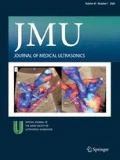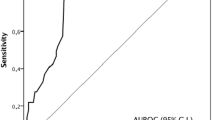Abstract
Objective
To investigate whether there are ultrasound characteristics that can suggest HCC in ultrasound surveillance of nodules in cirrhotic liver.
Methods
Data from 277 patients with hepatitis B virus-related nodules in cirrhotic liver undergoing ultrasound surveillance of the nodules for malignancy were reviewed. Size of the nodules ranged 6–23 mm. The nodules were followed by color Doppler ultrasound at 3- to 6-month intervals, with focus on size, shape, echogenicity, margin, halo sign, and vasculature. Suspicious malignant nodules underwent contrast-enhanced CT/MRI, and some indeterminate nodules underwent biopsy.
Results
Nodules in 189 patients were hypo/isoechoic/faint high echoic, 23 were hyperechoic, and 65 were both hypo/isoechoic/faint high echoic and hyperechoic. Forty-two patients developed hepatocellular carcinoma: 35 from nodules and 7 from background parenchyma. Fourteen nodules recessed (size >10 mm), 11 new nodules emerged (size >10 mm), and the total number of nodules increased over 5 years. All hepatocellular carcinomas developed from hypo/isoechoic/faint high echoic nodules, and no typical hyperechoic nodules developed into hepatocellular carcinomas. The size increased significantly when the nodules developed into hepatocellular carcinomas. No nodule presented an overt halo, seven hepatocellular carcinomas developed from nodules with a halo, and ill-defined margins of 16 nodules became well defined when they developed into hepatocellular carcinomas. No vasculature was detectable in the nodules, while it was detectable in eight hepatocellular carcinomas. No significant change occurred in nodules without malignancy.
Conclusion
The characteristics for dynamic surveillance of nodules in cirrhotic liver for malignancy should include nodule growth, margin, halo, and vasculature. Apart from evident growth, an ill-defined margin becoming a well-defined margin, a newly emerged halo, and newly detectable vasculature are strongly suggestive of nodule malignancy.


Similar content being viewed by others
References
Della Corte C, Colombo M. Surveillance for hepatocellular carcinoma. Semin Oncol. 2012;39:384–98.
Shah TU, Semelka RC, Pamuklar E, et al. The risk of hepatocellular carcinoma in cirrhotic patients with small liver nodules on MRI. Am J Gastroenterol. 2006;101:533–40.
Seki S, Sakaguchi H, Kitada T, et al. Outcomes of dysplastic nodules in human cirrhotic liver: a clinicopathological study. Clin Cancer Res. 2000;6:3469–73.
Rapaccini GL, Pompili M, Caturelli E, et al. Hepatocellular carcinomas < 2 cm in diameter complicating cirrhosis: ultrasound and clinical features in 153 consecutive patients. Liver Int. 2004;24:124–30.
Ignee A, Weiper D, Schuessler G, et al. Sonographic characterisation of hepatocellular carcinoma at time of diagnosis. Z Gastroenterol. 2005;43:289–94.
Min YW, Gwak GY, Lee MW, et al. Clinical course of sub-centimeter-sized nodules detected during surveillance for hepatocellular carcinoma. World J Gastroenterol. 2012;18:2654–60.
Furlan A, Marin D, Agnello F, et al. Hepatocellular carcinoma presenting at contrast-enhanced multi-detector-row computed tomography or gadolinium-enhanced magnetic resonance imaging as a small (≤ 2 cm), indeterminate nodule: growth rate and optimal interval time for imaging follow-up. J Comput Assist Tomogr. 2012;36:20–5.
Bruix J, Sherman M. Management of hepatocellular carcinoma: an update. Hepatology. 2011;53:1020–2.
Songdo S, Bae SH. Changes of guidelines diagnosing hepatocellular carcinoma during the last ten-year period. Clin Mol Hepatol. 2012;18:258–67.
Wernecke K, Vassallo P, Bick U, et al. The distinction between benign and malignant liver tumors on sonography: value of a hypoechoic halo. AJR Am J Roentgenol. 1992;159:1005–9.
Cosgrove D. Angiogenesis imaging–ultrasound. Br J Radiol. 2003;76:S43–9.
Furuse J, Iwasaki M, Yoshino M, et al. Evaluation of blood flow signal in small hepatic nodules by color Doppler ultrasonography. Jpn J Clin Oncol. 1996;26:335–40.
Borzio M, Borzio F, Croce A, et al. Ultrasonography-detected macroregenerative nodules in cirrhosis: a prospective study. Gastroenterology. 1997;112:1617–23.
Yoshimitsu K, Irie H, Aibe H, et al. Pitfalls in the imaging diagnosis of hepatocellular nodules in the cirrhotic and noncirrhotic liver. Intervirology. 2004;47:238–51.
Kim KW, Kim MJ, Lee SS, et al. Sparing of fatty infiltration around focal hepatic lesions in patients with hepatic steatosis: sonographic appearance with CT and MRI correlation. AJR Am J Roentgenol. 2008;190:1018–27.
Colagrande S, Paolucci ML, Messerini L, et al. Solitary necrotic nodules of the liver: cross-sectional imaging findings and follow-up in nine patients. AJR Am J Roentgenol. 2008;191:1122–8.
Lee JW, Kim S, Kwack SW, et al. Hepatic capsular and subcapsular pathologic conditions: demonstration with CT and MR imaging. Radiographics. 2008;28:1307–23.
Kim S, Maekawa Y, Matsuoka T, et al. Eosionophilic pseudotumor of the liver due to Ascaris suum infection. Hepatol Res. 2002;23:306.
Conflict of interest
The authors declare there are no financial or other relations that could lead to a conflict of interest.
Human rights statements and informed consent
All procedures followed were in accordance with the ethical standards of the responsible committee on human experimentation (institutional and national) and with the Helsinki Declaration of 1975, as revised in 2008 (5). Informed consent was waived by all patients for being included in the retrospective study.
Author information
Authors and Affiliations
Corresponding author
About this article
Cite this article
Wu, S., Tu, R., Liu, G. et al. Dynamic changes in ultrasound characteristics of nodules in cirrhotic liver and their implications in surveillance for malignancy. J Med Ultrasonics 41, 165–171 (2014). https://doi.org/10.1007/s10396-013-0494-8
Received:
Accepted:
Published:
Issue Date:
DOI: https://doi.org/10.1007/s10396-013-0494-8




